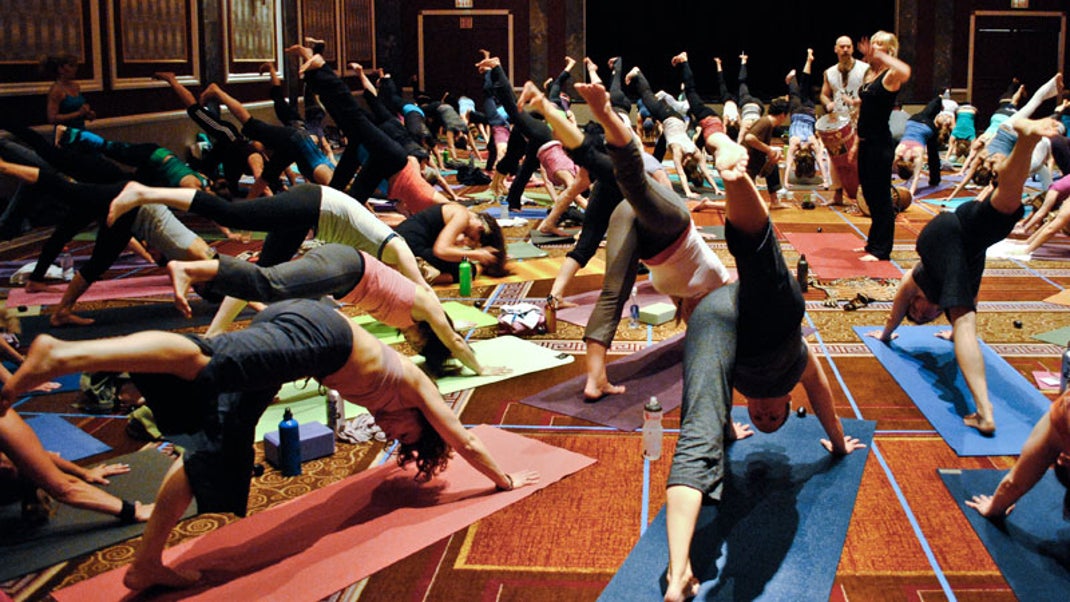Author Colleen Saidman Yee is a yoga instructor and author of the book “Yoga Anatomy.” Colleen has been teaching for over 30 years, and her newest project is to teach yoga teachers how to be more effective in their practice. She wrote Yoga Anatomy to help people understand how the body works when practicing yoga, and she shares that knowledge with people through workshops all across North America. Colleen was recently named one of the top 10 most influential yogis by the Huffington Post.
“My least favorite thing in the world is having to make a decision,” says veteran yoga teacher Colleen Saidman Yee. “I’m afraid that I’ll make the wrong one, suffer regret, and have to pay unpleasant consequences.” Still, through asana, Saidman Yee has created a path toward freedom from that fear—a process that involves tapping into her intuition via restorative yoga poses. “I realize that if I slow down and use these subtle practices to find a deep sense of relaxation, that a lot of what I’m searching for bubbles to the surface,” she says.
Here, learn more about Saidman Yee, develop a better connection with your intuition, and work through your own indecision. Her exclusive gentle sequence serves to help you find your own way. It also provides a sneak peek into her new Yoga Journal Master Class workshop on restorative yoga, which launches online this month.
In 1984, my next-door neighbor—who was into all sorts of “weird” stuff like yoga, journaling, and meditation—made it her mission to get me to yoga class. She nagged me for months until I begrudgingly agreed. (I’m sure that there was some sort of trade or bribe involved, but I can’t remember exactly what it was.)
I thought that I would be giggling at all these silly people who believed there was something mysterious and magical about “stretching.” I consider myself to be a pragmatist and had always envisioned yoga as a cult and the physical activity a joke. OK, well, I was wrong. The class kicked my ass and humbled me. The feeling and experience were both magical and mysterious and—dare I say it?—spiritual. My senses were clear, my mind was present, and I had an overwhelming sense of contentment that I hadn’t felt since I was a teenager. I remember walking out onto Broadway in New York City, which I had walked down hundreds of times, but the clarity of the color, sounds, and smells were so much crisper. It is from this clarity and relaxation that decisions become less dramatic. Yoga eventually became my guide back home to me.
I’m one of seven children and growing up, the main emphasis in our house was on education. My brothers and sister all went on to get master’s degrees and PhDs, and most are working in education. I was on the same trajectory, an A+ student in high school, but all of that changed on July 4, 1974, with screeching tires: I was run over by a car and suffered severe head trauma that left me unable to remember or process information the way I had before. I started using drugs and exercise to beat up my body because the distractions of a high or physical pain were so much less intense than my feelings of inadequacy were.
By the time I started yoga, I had already given up drugs, but the angst that was the impetus to start doing them was still there. As I kept returning to class, yoga started to address my deeper frustrations. It demanded that I sit with what I’d spent the previous decade running away from and covering up. Yoga has brought me to a place of loving my body and embracing my capabilities, and I believe that the practice has literally rewired my brain.
I still have moments of feeling that I don’t add up, but I can find where that’s stored internally and dive into those places with asana, meditation, and breathwork, and watch them lose their hold on me. This yoga stuff is quite miraculous.
Teaching yoga was never a goal or even a decision. But in 1997, when I was three-fourths of my way through the teacher-training program at Jivamukti Yoga, I informed Sharon [Gannon] and David [Life]—who run the studio—that I had no intention of teaching. I gave them a list of reasons why: I’m not a born teacher, I’m epileptic, I’m tone-deaf (chanting is a big part of their lineage), I’m petrified of public speaking, and so on. They nodded and listened, and as soon as I’d walked out of the studio, Sharon called me and said I was going to sub for her in three hours, that the class was sold out, and that she would be one of the students. Well, I did it, and now here I am still teaching 20 years later.
I’ve always been a huge fan of Savasana (Corpse Pose). I don’t think that I had one particular aha moment that made me decide to teach restorative yoga, but my love affair with restorative poses has grown over the years. It started with teaching a restorative pose at the end of my classes at my studio, Yoga Shanti (in New York). Then, about 10 years ago,
I started teaching entire classes dedicated to restorative poses. They are mind- and nervous-system-altering. I think my age has something to do with my love of propping the body and dropping in deeper and deeper. These poses quietly the mental chatter that is nonstop—relaying all sorts of conflicting information, stories, and possible outcomes. When we set up carefully in a restorative pose, the breath becomes easy and the body relaxes so that it doesn’t resist. The nervous system quiets down, and deep listening becomes possible. Clarity rises and fear dissipates.
We need to befriend, and listen to, the wisdom of the body. With yoga, I’ve developed a passion for exploring emotions and a method for freeing my body of the bondage caused by years of trying to protect myself. A gut reaction is a window into intuition, but many of us have become deaf to what our gut is telling us. Sometimes we want to deny the truth of a situation because we don’t trust ourselves, or we want someone else to make the decision, or we just plain don’t want to deal with the upheaval that could ensue. Or maybe we literally have negative feelings about our bellies because of what society has told us they should look like, and that area of the body has become hard, ignored, and shut down. Viscerally understanding and feeling the effects of restorative poses and breathwork has been a game-changer for me. You get in touch with what your gut is telling you, and you realize that you did the best you could; you stop beating yourself up with would-haves, should-haves, and could-haves because that is such a useless energy drain.
There are so many different restorative setups and poses that can benefit most conditions. Some of them need to be done gradually. For instance, if someone is sad, I wouldn’t want to put them in a restorative backbend right off the bat because energetically it would be like taking a glass out of the freezer and putting it into the oven. Instead, I’d ease them into three or four other poses building up to that backbend. When my daughters have menstrual cramps, I set them up in Supta Baddha Konasana (Reclining Bound Angle Pose). A supported side-lying position is good for nausea. Roll onto your side, place blankets between your lower legs, and one under your head. Place a candle, a photograph, or flowers nearby to look at. You can become very still here. Keeping your eyes open and looking at a stationary object helps ease the spinning quality of nausea and provides orientation. A Savasana (Corpse Pose) with weights, like sandbags, placed on your body is helpful when feeling ungrounded. There’s no end to the benefits of restorative yoga. Each setup is designed for optimal relaxation and breathing that will bring you comfort.
My hope is that yoga will someday be at the bedside of every hospital patient and that every health care professional will use it for self-care. Ten years ago, I started the Urban Zen Integrative Therapy program with Donna Karan and my husband, Rodney. Our goal has been to put the “care” back in health care. It’s a program for self-care that also offers training for health care professionals and yoga teachers who want to aid patient recoveries through yoga. Urban Zen Integrative Therapy teaches you how to apply yogic techniques when taking care of yourself or your patients. It didn’t inspire quick buy-in, but we kept pounding the pavement, and now the doors are springing open. Our hope is that soon all institutions such as schools, corporations, prisons, abuse centers, and rehab centers will offer yoga classes.
Yoga Journal’s new online Master Class program brings the wisdom of world-renowned teachers to your home-practice space, offering access to exclusive workshops with a different master teacher every six weeks. This month, Colleen Saidman Yee teaches a gentle and restorative asana class for overcoming roadblocks (like exhaustion, low self-esteem, and anxiety) to reach your true potential. If you’re ready to get a fresh perspective and maybe even meet a lifelong yoga mentor, sign up for YJ’s yearlong membership.
Conclusion:
Colleen Saidman Yee is a world-renowned yoga teacher who offers online classes through Yoga Journal’s Master Class program. Her goal is to put the “care” back in health care, and her teachings have inspired quick buy-in from institutions such as schools, corporations, prisons, abuse centers, and rehab centers. Colleen’s gentle and restorative asana class for overcoming roadblocks can help you reach your true potential. If you’re ready to get a fresh perspective and maybe even meet a lifelong yoga mentor, sign up for YJ’s yearlong membership today!




